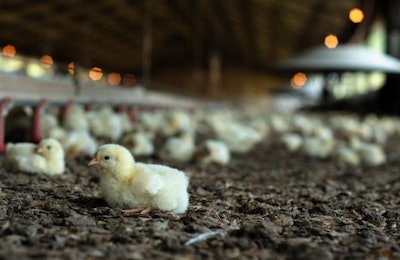
In an antibiotic-free world, a multitude of factors can contribute to necrotic enteritis. One expert said the best approach for controlling the disease is looking at the entire production system and making modifications to reduce disease risk.
Dr. Audrey McElroy, a professor and extension specialist focusing on intestinal health at Texas A&M University, identified key risk factors for the enteric disease and how best to manage broiler production to minimize risk. McElroy spoke as part of USPOULTRY’s 2017 Live Production, Welfare & Biosecurity Seminar in Nashville, Tennessee, on September 18, 2017.
ABF’s role
As antibiotic-free (ABF) production rises and the use of growth promoting antibiotics is dramatically scaled back in the US, necrotic enteritis is becoming a bigger disease challenge for broiler producers. The disease is caused by the bacteria Clostridium perfringens – a microbe present in almost all poultry operations – which produces a toxin causing the condition. McElroy said that removing antibiotics from the equation exposes the intestines to greater risks and requires farmers to take up other methods to protect their birds from the potentially fatal disease.
Managing necrotic enteritis is particularly challenging because of the multitude of factors that can cause the disease, McElroy said. In an ABF environment, successful management will require rethinking the entire feed strategy and focusing on basic management of the birds.
“There’s really no silver bullet,” McElroy said. “It’s going to be a holistic approach to going back to basic management, making changes and really providing attention to detail, getting the growers to provide attention to detail for those basic management strategies.”
4 factors and how they influence necrotic enteritis risk
1. Chick quality: McElroy said the quality of the chick is often overlooked when considering necrotic enteritis, but this is a key time for the development of disease risk because of the rapid growth of the intestines during this stage of life.
Farmers should ask themselves if the chick’s health was compromised before the bird even reached the farm. It’s important to monitor the quality of incubation and the quality of the transport conditions. If the conditions are not ideal, it can cause stress on the birds and compromise the development and ultimately the life-long health of the chick’s intestines, leading to higher necrotic enteritis risk.
2. Dietary considerations: Because it’s an intestinal disease, diet, feed formulation and how birds are fed play a critical role in managing disease risk. The goal is to manage the diet so birds efficiently utilize nutrients and not pass them through to the lower intestine where they can potentially contribute to necrotic enteritis.
- Protein: The biggest goal in preventing necrotic enteritis is keeping undigested proteins out of the lower intestinal tract. Farmers don’t want to see any undigested materials in the feces, but rather everything should be broken down. If the proteins are not broken down and digested by the bird, then they are feeding the Clostridium and elevating the risk for necrotic enteritis. McElroy said feed using high-quality proteins – both animal and vegetable proteins – and processing them to prevent the reduction of amino acid digestibility. Less digestible proteins harm the mucus barrier in the intestines and open the door for Clostridium to cause necrotic enteritis.
- Fat source: Like protein, the quality of the fat source in animal feed is important. She said any kind of rancidity is going to injure the intestinal tract.
- Non-starch polysaccharides (NSP): If adding wheat, rye, oats or barely to the diet – foods rich in NSPs – think about how enzymes must be adjusted so those nutrients are properly utilized by the bird. Those NSPs increase digestive viscosity and birds’ water intake is elevated, potentially leading to wetter litter and higher risk for both clostridium and coccidia.
- Calcium: Excessive levels of calcium in the diet can damage the intestine because they strengthen the toxins emitted by Clostridium that cause necrotic enteritis. McElroy said a study done in mice showed that the two toxins associated with necrotic enteritis are calcium dependent.
Additionally, calcium can also change the level of pH in the intestine and affect protein digestibility, which can elevate the risk for necrotic enteritis.
3. Coccidiosis vaccination: Farmers associate coccidia vaccination with necrotic enteritis, but the correlation does not necessarily exist. She said necrotic enteritis is nearly equally likely to occur in flocks that have and haven’t been vaccinated for coccidia. Coccidiosis can damage the intestine and therefore elevate the risk for necrotic enteritis.
4. House and Flock Management: McElroy emphasized the importance of basic management in preventing necrotic enteritis and managing its spread once it presents itself.
- Litter quality: Wet litter means the risk of necrotic enteritis is higher. Some anecdotal evidence suggests that necrotic enteritis is actually worse on clean litter than it is on built up litter. McElroy said that’s possibly because positive microbial populations exist in built up litter and removing it can be detrimental to the bird. Some farmers see success with acidifying the environment.
- Lighting programs: Farmers need to consider how the lighting program is stressing the bird and if that’s influencing the health of the bird.
- Water quality and sanitation: In a similar vein, clean feeding and watering equipment is important to control disease risk. Farmers should check their systems to ensure they are clean and clean feed pans to prevent any buildup of fecal matter or other undesirable substances.
- Temperature stress: One factor farmers may not consider is the role of heat or cold stress on the birds. She questioned how often temperature stress may be occurring without farmers realizing it. When necrotic enteritis appears, farmers need to examine their temperature logs and look to see how the environment changed – if it did change at all. As always, stress can lead to damaged intestines which can lead to heightened necrotic enteritis risk.


















